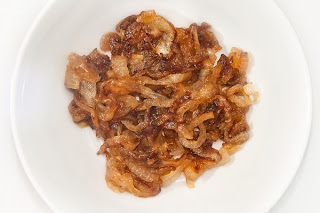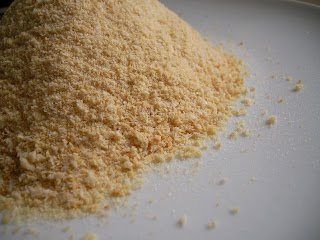How to Stir Fry??

The Chinese have a way of manipulating food that I wanted to learn about so I dug out the wok that I inherited when I got married and started reading up and experimenting.
What I learned about the ancient technique of Stir-Fry is you have to be prepared before you start. Often I talk about prepping ingredients before you start cooking, but this is a must when doing stir-fry. In fact prepping the ingredients will take longer than the actual cooking. Once you get your pan hot…..you can’t stop.
Stir-frying will also give you some practice with your cutting skills since each ingredient will be bite size (Have you ever seen a knife in a Chinese restaurant?) and have different cuts. Once prepped, I like to put the ingredients in individual bowls separated by cooking times.
The technique is to quickly fry the ingredients in a large pan over high heat while constantly stirring to preserve flavor, color and texture of the food and keep the vegetables crisp. Easy enough.
Typically one uses a wok; a large deep bowl made of thin metal with gentle curved sides. The heat concentrates at the bottom of the pan and the curved sides allow you to push the ingredients to cooler areas. You can use a typical frying pan, but it won’t cook as fast thus keeping your vegetables as crisp as you would want.
Other than a few specialty ingredients, you can use whatever you have on hand to make a stir-fry. It’s a great way to clean out the vegetable drawer. Because you’ll be cooking at very high heat, you want to use a high smoking point oil like peanut, safflower, corn, or canola. Some of the specialty ingredients that you should be able to find at your local supermarket are soy sauce, hoisin sauce, and chili sauce. Short or medium grained rice is best for accompanying your stir-fry.
You start by prepping the meat or chicken. Cut the meat into thin bite-size slices and marinate to protect it from overcooking. The marinade can be made with a variety of liquids depending on the flavor you are trying to obtain. Typical marinade ingredients include chicken stock or beef stock, soy sauce, hoisin sauce, chili sauce, corn starch, brown sugar, rice wine or dry sherry. Marinate for a least one hour, longer is better.
Prepare an aromatic mixture consisting of finely chopped herbs and spices that will add flavor and aroma to the stir-fry. Typical aromatics include garlic, scallions, red pepper flakes, shallots, and chili peppers to name a few. Next prepare your vegetables by cutting them into small pieces and separating according to their cooking times. Slower cooking vegetables like asparagus and green beans will be added before faster cooking vegetables like pea pods and tomatoes. Now you’re ready to stir-fry.
Check out my recipe for Chicken and Broccoli Stir-Fry but experiment with different marinades, aromatics, and vegetables to create your own special stir-fry.
Back to Techniques
How to Make Homemade Mayonnaise??
Basic Mayonnaise -To scale this recipe up or down, the ratio is one yolk per cup of oi
Ingredients
1 egg yolk
a heavy pinch of salt
a pinch of sugar
a few grinds of black pepper (use white if you don’t want black specks in your mayonnaise)
1 teaspoon vinegar
1 teaspoon lemon juice
About 1 cup neutral oil
Mix yolk, salt, sugar and pepper together until well blended and yolk lightens in color.
Mix in the vinegar.
While whisking constantly, drizzle in the oil very slowly. Begin with just a drop or two at a time. Once you have added about half the oil, you can add it in a very thin stream. Keep whisking the entire time you are adding the oil.
When finished, the mayonnaise will not be as thick as store bought mayonnaise. Let it sit, refrigerated, for at least half an hour. Stir, and taste for seasoning. If necessary, whisk in a pinch more salt, sugar or another teaspoon or so of vinegar. Wait before tasting because it takes awhile for the salt to dissolve into all of the oil.
Note that raw egg yolk is used as the emulsifier. As with all raw eggs, there is some risk of salmonella contamination. The USDA advises that the elderly, very young and those with compromised immune systems should avoid raw eggs. Use the freshest eggs possible or substitute pasteurized eggs.
If you own a food processor, I have a great video by Chef Todd Mohr on my Caesar Salad Recipe web page. The video is at the end of the post. Besides showing you how to make a great Caesar Salad, Chef Todd shows you how to make a basic mayonnaise using a food processor. His video describes how to make mayonnaise without a recipe and I highly recommend you check it out.
How to Make Clarified Butter??
Let the butter sit for a minute or two for all the layers to separate. Then, skim off the foam and spoon or carefully pour the butterfat into a separate container, making sure to leave the water and milk solids behind.
How to Cut an Onion but it still makes you cry
- Using a chef's knife, cut the stem end almost off but leave a little to grab so you can start peeling. Peel all the outside skin off.
- Place the onion on the cut end with the root end facing up. If there are any excess roots sticking out, pinch them off with your fingers. Now slice the onion in half long ways. By leaving the root attached, it will help keep the onion together while slicing.
- Take each half of the onion and lay it down flat on your cutting board. Make multiple cuts long ways from top to bottom but not through the root at the end.
- Depending on on the fineness you want your dice will determine how many cuts you will make. The more cuts, the finer the dice.
- Turn the onion 90 degrees and make multiple cuts across the onion being sure to keep your fingers curled under so you don't cut them. How many slices will again depend on how fine a dice you are looking for
How to roast a pepper??
1. Preheat the oven to 400 degrees (200 degrees Celsius). Rub the peppers with olive oil, and season with salt and pepper. Roast for 30-45 minutes, or until the skins turn dark brown and wrinkled.
2. Place onions in a large glass bowl and cover with plastic wrap or an airtight lid. Let rest until the bottom of the bowl is cool to the touch. Carefully peel off skins of the peppers, remove seeds and stems, and discard. Reserve the flesh. Use immediately, or refrigerate for up to a week.
How to caramelize onions??
2 tablespoons butter5-6 onions, thinly sliced (I used fewer in the pictures, but it is always better to make more)
pinch of kosher salt
1 tablespoon agave nectar or honey
water
1. Melt the butter in a large pan set over low heat. Add in onions, a generous pinch of salt, and the agave nectar. Stir every now and then for even cooking.
2. As onions dry out, add in a splash of water to keep the onions from burning. Keep cooking over low heat until onions are a warm golden brown. Depending on how hot the pan is, this could take from 30 minutes to an hour. Serve immediately, store in the refrigerator, or freeze.
How to make your own perfect mashed potatoes??
1. Peel potatoes (or don’t, it’s up to you. But if you do leave the skins on for your mashed potatoes, make sure you always cut the potatoes before throwing them in the pot. Unpeeled potatoes boiled whole will result in gluey mashed potatoes).
2. Slice the potatoes 1/2 inch thick. Rinse, and place in a large pot. Cover potatoes with cold water. Set over high heat and bring to a boil. When water comes to a boil, add in a tablespoon of salt (or less if you’re only doing a couple of potatoes). Boil potatoes until tender and will split down the center when pierced with a knife, about 20 minutes.
3. Drain potatoes in a colander, and press through a ricer.
4. Transfer to the bowl of an electric mixer fitted with a whisk attachment and add in melted butter and milk. Depending on how many potatoes you make, this may be anywhere from 4-12 tablespoons of butter, and up to a cup of milk. Be very careful adding the milk, though. Adding too much can really ruin the potatoes, so start small, adding about a 1/2 a cup at first, and then gradually adding more until you achieve the consistency you want. Whisk the potatoes until light and fluffy. Then taste. If they are too dry, add a little milk, or cream. If they aren’t flavorful enough, you may want to add more butter, or more salt or pepper. This may be a time to get crazy and toss in some sour cream or buttermilk or cream cheese. For Thanksgiving, a little extra richness is what you’re going for, so have fun and be creative.
5. Sometimes I like to top my mashed potatoes with caramelized onions or shallots when I serve them at the table. You can do whatever you want.
How to Make Breadcrumbs??
Preheat the oven to 300 degrees F.
Cut the crusts off the bread, if desired. If you prefer more variation in color for your breadcrumbs, leave on the crusts.
Lay the bread in a single layer on a baking sheet. Once the bread is dry and barely starting to brown, about 10 minutes. Remove from the oven and let it cool.
Break the bread into 1 to 2 inch pieces and place in the bowl of a food processor. You may need to do this in two batches.
Pulse until the breadcrumbs reach the desired consistency. I like my breadcrumbs to have a mixture of pebble-sized pieces as well as finely ground crumbs, but use whatever consistency suits your needs the best.
How to Peel a Peach??
With a paring knife, cut an “X” through the skin in the bottom of each peach.
Bring a medium or large pot (depending on the number of peaches) of water to a boil. Fill a large bowl with cold water and some ice. Do this step now so it’s ready to go when you need to dunk the peaches.Place the peaches into the boiling water for 45 seconds. If you leave them much longer, the peaches will start to cook and soften.
Using a slotted spoon, lift the peaches out of the water and immediately transfer to the bowl of ice water. Let the peaches sit in the ice water for a few minutes to cool.
Starting at the “X” on the bottom of the peaches and using your fingers or a paring knife, peel off the skin from each peach.
How to Peel Ginger??
Cut off a piece of the ginger from the larger ginger root.
Using the inside of a small spoon, scrape the skin off the ginger, working into the crevices as necessary.
Now the ginger is peeled, the waste is minimal and the ginger is ready to be sliced, chopped or grated. That’s it!








